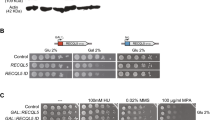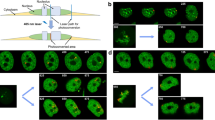Abstract
Mutants capable of a high frequency of cytoduction (Hfc+) were obtained in a haploid strain of Saccharomyces cerevisiae, suggesting impaired cytogamy. Nine of the 68 Hfc+ mutants showed the antisuppressor effect with respect to mutations of the SUP35 and SUP45 genes, which code for translation termination factors, or to the [PSI +] factor, which is the prion form of Sup35. Cosegregation of the characters “higher frequency of cytoduction” and “antisuppression” was demonstrated for three Hfc+ mutants. One (HFC12-2) of the Hfc+ mutations exerted a dominant antisuppressor effect with respect to [PSI +] and had no effect on [PSI +] maintenance. On the strength of the results, an interaction was assumed for translation termination components and cytoskeleton proteins, which play a role in karyogamy in yeasts.
Similar content being viewed by others
REFERENCES
Zhouravleva, G., Frolova, L., Le Goff, X., et al., Termination of Translation in Eukaryotes Is Governed by Two Interacting Polypeptide Chain Release Factors, eRF1 and eRF3, EMBO J., 1995, vol. 14, pp. 4065–4072.
Frolova, L., Le Goff, X., Rasmussen, H.H., et al., A Highly Conserved Eukaryotic Protein Family Possessing Properties of Polypeptide Chain Release Factor, Nature, 1994, vol. 372, pp. 701–703.
Inge-Vechtomov, S.G., Zhouravleva, G.A., and Philippe, M., Eukaryotic Release Factors (eRFs) History, Biol. Cell., 2003, vol. 95, pp. 195–209.
Borchsenius, A.S. and Inge-Vechtomov, S.G., On the Role of the SUR35 and SUR45 Genes in the Cell Cycle Control in Saccharomycete Yeasts, Dokl. Akad. Nauk, 1997, vol. 353, pp. 553–556.
Tikhomirova, V.L. and Inge-Vechtomov, S.G., Sensitivity of sup35 and sup45 Mutants in Saccharomyces cerevisiae to Antimicrotubule Drug Benomyl, Curr. Genet., 1996, vol. 30, pp. 44–49.
Borchsenius, A.S., Tchourikova, A.A., and Inge-Vechtomov, S.G., Recessive Mutations in SUP35 and SUP45 Genes Coding for Translation Release Factors Affect Chromosome Stability in Saccharomyces cerevisiae, Curr. Genet., 2000, vol. 37, pp. 285–291.
Basu, J., Williams, B.C., Li, Z., et al., Depletion of a Drosophila Homolog of Yeast Sup35p Disrupts Spindle Assembly, Chromosome Segregation, and Cytokinesis during Male Meiosis, Cell Motil. Cytoskeleton, 1998, vol. 39, pp. 286–302.
Valouev, I.A., Kushnirov, V.V., and Ter-Avanesyan, M.D., Yeast Polypeptide Chain Release Factors eRF1 and eRF3 Are Involved in Cytoskeleton Organization and Cell Cycle Regulation, Cell Motil. Cytoskeleton, 2002, vol. 52, pp. 161–173.
Newnam, G.P., Steenberger, J.N., and Chernoff, Y.O., Genetic Study of Interactions between the Cytoskeletal Assembly Protein Sla1 and Prion-Forming Domain of the Release Factor Sup35 (eRF3) in Saccharomyces cerevisiae, Genetics, 1999, vol. 153, pp. 81–94.
Zhouravleva, G.A., Alenin, V.V., Inge-Vechtomov, S.G., and Chernoff, Y.O., To Stick or Not to Stick: Prion Domains from Yeast to Mammals, Recent Res. Dev. Mol. Cell. Biol., 2002, vol. 3, pp. 185–218.
Bailleul-Winslett, P.A., Newnam, G.P., Wegrzyn, R.D., and Chernoff, Y.O., An Antiprion Effect of the Anticytoskeletal Drug Latrunculin A in Yeast, Gene Expression, 2000, vol. 9, pp. 145–156.
Marsh, L. and Rose, M.D., The Pathway of Cell and Nuclear Fusion during Mating in S. cerevisiae, The Molecular and Cellular Biology of the Yeast Saccharomyces, Prangle, G.R., et al., Eds., New York: CSHL, 1997, pp. 827–888.
Bannikova, M.A., A Genetic Study of Cytoduction in Yeast Saccharomyces cerevisiae, Cand. Sci. (Biol.) Dissertation, Leningrad: Leningrad State Univ., 1986.
Andrianova, V.M., Samsonova, M.G., Sorova, Y.V., and Inge-Vechtomov, S.G., Catalogue of Peterhof Genetic Collection of Yeast Saccharomyces cerevisiae, St. Petersburg: NIIKh St. Petersburg State Univ., 2003.
Zakharov, I.A., Kozhina, T.N., Kozhin, S.A., and Fedorova, I.V., Sbornik metodik po genetike drozhzheisakharomitsetov (Methods of the Genetics of Saccharomycetes), Leningrad: Nauka, 1984.
Guthrie, C. and Fink, G.R., Guide to Yeast Genetics and Molecular Biology, Methods of Enzymology, vol. 194, Abelson, G.N. and Simon, N.I., Eds., New York: Academic, 1990.
Tuite, M.F., Mundy, C.R., and Cox, B.R., Agents That Cause a High Frequency of Genetic Change from [psi +] to [psi -] in Saccharomyces cerevisiae, Genetics, 1981, vol. 98, pp. 691–711.
Inge-Vechtomov, S.G. and Repnevskaya, M.V., Phenotypic Expression of Primary Lesions of Genetic Material in Saccharomyces Yeast, Genome, 1989, vol. 31, pp. 497–502.
Inge-Vechtomov, S.G., Tikhodeev, O.N., and Karpova, T.S., Selective Systems for Isolating Recessive Ribosome Suppressors in Saccharomycete Yeasts, Genetika (Moscow), 1988, vol. 24, no.7, pp. 1159–1165.
Inge-Vechtomov, S.G. and Karpova, T.S., A Selective System of Cytoduction with the Use of Recessive Suppressors in Saccharomycete Yeasts, Genetika (Moscow), 1984, vol. 20, no.3, pp. 398–407.
Schmidt, M.E., Brown, T.A., and Trumpower, B.L., A Rapid and Simple Method for Preparation of RNA from Saccharomyces cerevisiae, Nucleic Acids Res., 1990, vol. 18, pp. 3091–3092.
Sambrook, J., Fritsch, E.F., and Maniatis, T., Molecular Cloning: A Laboratory Manual, Cold Spring Harbor, New York: Cold Spring Harbor Lab., 1989.
Polaina, J. and Conde, J., Genes Involved in a Control of Nuclear Fusion during the Sexual Cycle of Saccharomyces cerevisiae, Mol. Gen. Genet., 1982, vol. 186, pp. 253–258.
Osipov, K.V., Volkov, K.V., Soom, M. Ya., and Mironova, L.N., Translation Fidelity in Yeast: The N Domain of Sup35p (eRF3) and Reading of Stop Codons, Tezisy nauchnykh dokladov III s”ezda biokhimicheskogo obshchestva (Proc. III Meet. of the Biochemical Society), St. Petersburg: Farmatsevticheskoe Izdatel’stvo Faros-Plyus, 2002.
Kikuchi, Y., Shimatake, H., and Kikuchi, A., A Yeast Gene Required for G1-to-S Transition Encodes a Protein Containing an A-Kinase Target Site and GTPase Domain, EMBO J., 1988, vol. 7, pp. 1175–1182.
Ter-Avanesyan, M.D., Kushnirov, V.V., Dagkesamanskaya, A.R., et al., Deletion Analysis of the SUP35 Gene of the Yeast Saccharomyces cerevisiae Reveals Two Nonoverlapping Functional Regions in Encoded Protein, Mol. Microbiol., 1993, vol. 7, pp. 683–692.
Shiina, N., Gotoh, Y., Kubomura, N., et al., Microtubule Severing by Elongation Factor 1, Science, 1995, vol. 266, pp. 283–286.
Condeelis, J., Elongation Factor 1, Translation and Cytoskeleton, Trends Biochem. Sci., 1995, vol. 20, pp. 169–170.
Liu, G., Tang, J., Edmonts, B.T., et al., F-Actin Sequesters Elongation Factor 1 from Interaction with Aminoacyl tRNA in pH-Dependent Reaction, J. Cell Biol., 1996, vol. 135, pp. 953–963.
Schmidt, A., Kunz, J., and Hall, M.N., TOR2 Is Required for Organization of Actin Cytoskeleton in Yeast, Proc. Natl. Acad. Sci. USA, 1996, vol. 93, pp. 13 780–13 785.
Barbet, N.N., Schneider, U., Helliwell, S.B., et al., TOR Controls Translation Initiation and Early G1 Progression in Yeast, Mol. Cell. Biol., 1996, vol. 7, pp. 25–42.
Frolova, L., Le-Goff, X., Zhouravleva, G., et al., Eukaryotic Polypeptide Chain Release Factor eRF3 Is an eRF1 and Ribosome-Dependent Guanosine Triphosphatase, RNA, 1996, vol. 2, pp. 334–341.
Author information
Authors and Affiliations
Additional information
Translated from Genetika, Vol. 41, No. 2, 2005, pp. 178–186.
Original Russian Text Copyright © 2005 by Borchsenius, Repnevskaya, Kurischko, Inge-Vechtomov.
Rights and permissions
About this article
Cite this article
Borchsenius, A.S., Repnevskaya, M.V., Kurischko, C. et al. Association between defects of karyogamy and translation termination in yeast Saccharomyces cerevisiae . Russ J Genet 41, 122–129 (2005). https://doi.org/10.1007/s11177-005-0035-7
Received:
Issue Date:
DOI: https://doi.org/10.1007/s11177-005-0035-7




